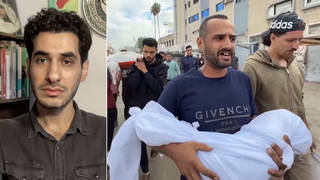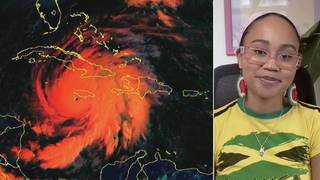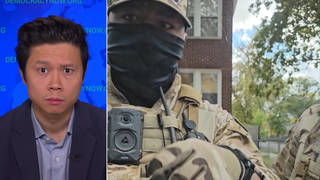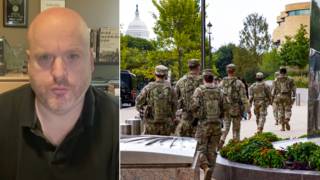
Topics
Guests
- Shane Baueraward-winning investigative journalist and senior reporter at Mother Jones magazine. His cover story is “The Making of the Warrior Cop.”
In a new cover story for Mother Jones magazine, “The Making of the Warrior Cop,” senior reporter Shane Bauer goes inside the corporations and government departments involved in enabling police departments to acquire anything from bayonets to semi-automatic rifles and drones. Reporting from the exposition called “Urban Shield” — which organizers call the largest first-responder training in the world — Bauer says that the equipment police departments have received from the military pales in comparison to the amount of gear purchased from private companies. The Department of Homeland Security has provided some $41 billion in funding to local police departments to buy the equipment from various corporations, on top of more than $5 billion from the Pentagon since 1997.
Transcript
JUAN GONZÁLEZ: We continue our conversation about policing communities by looking at who is involved in the increasing militarization of police departments across the country. Shane Bauer’s cover story for Mother Jones magazine, headlined “The Making of the Warrior Cop,” gives us a tour through the corporations and government departments involved in enabling police departments to acquire anything from bayonets to semi-automatic rifles to drones. Reporting from the exposition called Urban Shield, which, according to organizers, is the largest first-responder training in the world, Bauer says that the equipment police departments have received from the military, quote, “pales in comparison to the amount of gear purchased from private companies.”
AMY GOODMAN: The Department of Homeland Security provides funding to local police departments to buy equipment from various corporations. Shane Bauer writes, quote, “The Department of Defense has given $5.1 billion worth of equipment to state and local police departments since 1997, with even rural counties acquiring things like grenade launchers and armored personnel carriers. But Homeland Security has handed out grants worth eight times as much—$41 billion since 2002.” Let’s go to a clip from the Mother Jones piece. Shane Bauer, who will join us in a minute, starts by asking Urban Shield spokesperson, Sergeant JD Nelson, a question.
SHANE BAUER: Do you think there’s any validity to the criticism that the United States is kind of increasingly becoming a police state?
SGT. JD NELSON: I think there is some validity to that.
SHANE BAUER: We’re at Urban Shield in Oakland, California. It’s a cop convention where this weekend SWAT teams from around the Bay Area and around the world are going to be competing around the Bay.
AMY GOODMAN: That is Mother Jones journalist Shane Bauer, who joins us now from University of California, Berkeley, studios, the award-winning investigative journalist, senior reporter at Mother Jones magazine. His cover story is headlined “The Making of the Warrior Cop.” Shane is also the journalist who was imprisoned for two years in Iran.
Welcome back to Democracy Now!, Shane. So, take us through this expo, and these astounding figures. I mean, we’ve heard a lot about the weapons coming back from Iraq and Afghanistan, the Pentagon recycling them in towns, cities, hamlets, in their police departments. But the fact that that amount of equipment is dwarfed by direct grants to these communities to buy money—to buy weapons from weapons manufacturers?
SHANE BAUER: Yeah, thanks for having me on, Amy. So, you know, Ferguson is, I think, a good example of this. In Ferguson, a lot of the kind of gear that we saw on television that the police had, you know, throughout the crisis there was not actually military gear. It was stuff, very similar equipment, bought from private companies. And what we’re seeing now is, you know, some towns, some counties are actually giving back the equipment or trying to give back the military equipment, but they also have, you know, very similar stuff that they’re buying from private companies. An example is in Arizona. Sheriff Joe Arpaio kind of made a show of giving some of his gear back, and he put on display all of his kind of military stuff he had, and then he showed the much kind of newer, more up-to-date stuff that he’s buying from companies. And this industry has really, you know, sprung up post-9/11, when Homeland Security start giving grants to local communities for counterterrorism. A lot of the companies I saw at Urban Shield were actually started after 9/11. So they give this stuff for counterterrorism, but, of course, they can use it for anything they want, and most of what it’s used for is drug raids.
JUAN GONZÁLEZ: And what does this mean in terms of these manufacturers or suppliers, in terms of their actually going around lobbying these local governments to buy their material?
SHANE BAUER: Well, I think one example that I saw at Urban Shield was a company called the Armored Group. They were selling the kind of big APC-style armored vehicles. And if you go on their website, you see that they tell local police departments that “if you want to buy our vehicle, we actually have a grant writer that will write the grant for you for Homeland Security so you can get the funding.” They also suggest that they use forfeiture money. This is money that is taken in criminal investigations, money or property that police departments take in criminal investigations, even when the defendants are not actually prosecuted in the cases. That money can also be used to buy similar—the same equipment from these companies.
AMY GOODMAN: I want to turn to another clip from your report for Mother Jones. In this video, you’re speaking to Jeremy Johnson of the Armored Group.
JEREMY JOHNSON: Like you, I’ve been all over the world. I’ve seen a lot of the stuff. And I see a lot of the differences. You know, this is not a—they’re not going in to just take care of business. They’re there to, hopefully, handle a situation that could get out of hand, right?
SHANE BAUER: Yeah, yeah.
JEREMY JOHNSON: But you never hear about the ones they handle. I think that’s where it gets a little disconnect from what they want. But you’re right. Some of these trucks do look intimidating—for a reason, though. They should. You know, you don’t want to pull up a Chevy Chevette in front of a house and say, “Here, we’re going to get you.” You’re not going to get the effect you want.
JUAN GONZÁLEZ: Yeah, I want to turn to another clip from your report, one that features something unbelievable—a university, the University of California, Berkeley, having a SWAT team. After they staged a hostage rescue simulation, you spoke to Eric Tejada of UC Berkeley’s Special Operations.
LT. ERIC TEJADA: It was actually around ’92, ’94, there was an attack on the chancellor of the—
SHANE BAUER: OK.
LT. ERIC TEJADA: —at his residence, which is on campus.
SHANE BAUER: OK, uh-huh.
LT. ERIC TEJADA: And we realized at the time that we didn’t have any resources to deal with that kind of threat when it took place.
SHANE BAUER: Yeah, OK.
LT. ERIC TEJADA: So, and I think about 15 years before, they had some kind of semblance of a SWAT team.
SHANE BAUER: OK.
LT. ERIC TEJADA: So they regenerated the idea of—
SHANE BAUER: Oh, I see.
LT. ERIC TEJADA: —activating a SWAT team.
JUAN GONZÁLEZ: That was Eric Tejada of UC Berkeley’s Special Operations. Most people might be surprised to hear the University of California, Berkeley, has a SWAT team. Shane Bauer, could you tell us what kind of operations the team has physically carried out?
SHANE BAUER: Yeah, well, I mean, this is interesting, because this scenario, they were doing a kind of high-stakes hostage rescue. They would later go on a boat in the bay to kind of dismantle a terrorist IED. They would go into a church, where, you know, a kind of pretend militant atheist group is holding church members hostage. But when I asked them what they do day to day, most of what they respond to are muggings of students—you know, the kind of normal police work that police departments do. They’re kind of going in, you know, fully armed, geared up in this kind of military-style gear, busting into houses.
You know, I think another aspect that is interesting about this whole situation with the Homeland Security money is that there’s incentive for kind of new equipment. One thing that I saw was a device that attaches to a gun, and it sends out radiation waves that temporarily blind the person it’s pointed at for 10 minutes by—what the vendor told me was, by scrambling their ocular fluid. And that’s something that’s going to be hitting the market early next year.
AMY GOODMAN: So, this is both an expo that you went to, Urban Shield, but also there was a lot of role playing.
SHANE BAUER: Right.
AMY GOODMAN: Now, you had your press credentials revoked, is that right?
SHANE BAUER: Yeah.
AMY GOODMAN: Your press credentials were revoked on the last day of the conference. I want to go to a clip, the third day of the conference, and you filmed a police officer asking you to leave the premises.
SHANE BAUER: They told us that we were OK here. Said, “Take their media badges”?
POLICE OFFICER: Yeah, and said, “Hold onto”—
SHANE BAUER: Did he explain why?
POLICE OFFICER: He just said because they were in violation of the rules for filming inside of one of the sites; they were advised to film inside the site.
SHANE BAUER: What site?
POLICE OFFICER: I don’t know.
SHANE BAUER: They didn’t even say what site.
POLICE OFFICER: I assume it’s mine. I assume it’s this site.
AMY GOODMAN: Before you were removed from the conference, Shane, there were numerous instances in which your work was shut down at Urban Shield. So, explain—
SHANE BAUER: Right.
AMY GOODMAN: Just give us the global picture of what’s happening, the expo and these other role plays that you were trying to cover that happened outside, like in San Francisco and the bridge.
SHANE BAUER: Yeah, so there was—basically, it was a four-day event. The first two days was an expo. There was an expo hall where all kinds of companies were showing their equipment—guns, trucks, drones, you know, robots that can be printed with 3D printers—trying to sell them to the local police departments. The next two days was a 48-hour straight exercise, where SWAT teams were actually competing with each other, going through around 35 scenarios. And each one, they’re kind of getting points. These were a lot of kind of Bay Area SWAT teams. There were some international SWAT teams from Singapore, South Korea. The U.S. Marines was a team. There was, you know, teams like UC Berkeley, a prison SWAT team. And I had gone to some of these events, and on the morning of the second day, they took our press credentials.
JUAN GONZÁLEZ: And, Shane, drones obviously have gotten a lot of attention in recent years. Did you get any sense that that was a hot item among these different law enforcement agencies this time around?
SHANE BAUER: Oh, yeah. There were a ton of drones. Actually, when I got kicked out, there was a vendor. Each of these kind of sites where they were doing these scenarios had a particular vendor. And at that site, there was a drone vendor who we had interviewed. And he was hoping to use their drones, his company’s drones, in the exercise on the Bay Bridge, but because of FAA regulations, they were not allowed to use them. You know, the county in—Alameda County hasn’t gotten approval yet to use them. But you saw, you know, a big thing right now is the 3D-printable drones. So, police departments can print out a drone, attach the wiring and, you know, set it out.
AMY GOODMAN: There’s been a lot of protest in Oakland around urging the Oakland mayor, Jean Quan, to cancel the Urban Shield conference next year. Can you talk about these protests and the significance of this happening in Oakland in this post-Ferguson period?
SHANE BAUER: Yeah, well, Urban Shield has been happening for years. It’s been going on since the mid-2000s. And in recent years, there’s been regular protest of it. And this year, in particular, Jean Quan said that Urban Shield will not be allowed to come back to Oakland. Now, the county has said, “Yes, they will.” So there’s kind of a battle between the city and the county right now.
You know, when I was at Urban Shield, the protests, something I noticed was that the protests were referencing Ferguson quite a bit. And that was something that just wasn’t really talked about on the inside; inside Urban Shield, there wasn’t any discussion of Ferguson. But at the same time, you know, I was seeing T-shirts for sale that—where, you know, you see kind of an image of a gun sight, and says, “This is my peace sign.” You see, you know, kind of this Spartan imagery, very militaristic kind of imagery, that in many ways, you know, is kind of—
AMY GOODMAN: What is “This is my peace sign”? What is it actually showing?
SHANE BAUER: That’s a sight of an AR-15, looking kind of down the scope of an AR-15 sight.
JUAN GONZÁLEZ: And, Shane, the—
SHANE BAUER: And, you know, I think this—
JUAN GONZÁLEZ: I’m sorry. Go ahead.
SHANE BAUER: Oh, you know, I think something that—something that really was interesting to me about being there was this kind of overlap with the military. You know, some of these companies that I seen and vendors that I spoke to were from the military. Their companies were actually set up to distribute to the military, and they’ve since kind of come over to also bringing in police. You know, the Marines were a team competing there. I talked to the Marines after one of their scenarios, and they said that they actually learn from the police. The spokesperson of Urban Shield told me, you know, “We should be talking not about militarization of the police, but policization of the military.” There’s this kind of interesting dynamic now where the Marines are actually learning from the kind of urban SWAT team tactics, to bring back and kind of train their people.
JUAN GONZÁLEZ: Shane, I wanted to ask you about the Pentagon’s 1033 program. It’s transferred more than $5.1 billion in military equipment to local agencies since 1991. That includes some 600 mine-resistant armor-protected vehicles, or MRAPs.
SHANE BAUER: Yeah.
JUAN GONZÁLEZ: Last month, during a Senate hearing on police militarization, Brian Kamoie of the Department of Homeland Security defended the program. He said equipment helped locate the surviving suspect after the Boston Marathon bombing last year.
BRIAN KAMOIE: The response to the 2013 Boston Marathon bombing demonstrated how preparedness grant investments have improved capabilities. Grant-funded equipment, such as the forward-looking infrared camera on a Massachusetts State Police helicopter, enabled the apprehension of Dzhokhar Tsarnaev, while enhancing the personal safety of law enforcement officers and protecting public safety.
JUAN GONZÁLEZ: That was Brian Kamoie of the Department of Homeland Security. So, isn’t—some people would say that’s a justification for all of this hardware.
SHANE BAUER: Right. I mean, you know, there’s no doubt that people in a kind of extreme situation are going to want to have some kind of response. The issue is that a lot of this hardware is going to small towns. I mean, everybody is getting this stuff. And most of it is used for drug raids. It’s the kind of situations where there has been—there’s not an active shooter, there’s not a hostage scenario—the kind of stuff that police often talk about in why they need this equipment. It’s used to raid people’s houses, you know, often in no-knock raids to try to find drugs. And these SWAT teams are mostly used—about 71 percent of the time they’re used to target people of color, even though the people that are the most likely to be, you know, the active shooters, the hostage takers, are white. In North Carolina in one town, African Americans were targeted 47 times the amount of white people by SWAT teams.
AMY GOODMAN: Shane, as we wrap up, I wanted to switch gears. As we talk to you and you’re talking about the amount of money that’s going into the militarization of police at home, we’re seeing the U.S. attack Syria and Iraq, dealing with the Islamic State. You were held in Iran with Josh Fattal and Sarah Shourd for—well, you and Josh for two years by the Iranian authorities; you were imprisoned. And I wanted to know your reaction to when you see, for example, the video of James Foley, the horrid video of his beheading, and then his mother coming out and saying she was threatened that if she dared try to raise any kind of ransom, she herself would be prosecuted. Your thoughts on this issue, as journalists like yourself have been held?
SHANE BAUER: I mean, it’s terrible, I mean, all the way around. My heart goes out to the Foley family, to the families of all of the people who are held hostage in Syria, including, you know, Syrians. Most of the people that are missing right now are Syrians. And, you know—
AMY GOODMAN: In fact, before you were arrested, you and Sarah worked in Syria. You were teaching English in Syria.
SHANE BAUER: Right. Yeah, I was actually working as a journalist in Syria. Sarah was teaching. And, you know, it’s still hard for me to really get my head around what is happening there. It’s just such a different place. And I do, you know, wish that our government did more, that people weren’t—people like Foley’s mom didn’t face punishment for trying to raise money to get her son out of prison. I mean, it’s not a simple situation. You know, giving money to the Islamic State is not the answer, either. But we need to have kind of a more active way of dealing with this, I think.
AMY GOODMAN: Shane, thanks so much for being with us. Shane Bauer, award-winning investigative journalist, senior reporter at Mother Jones magazine, his cover story headlined “The Making of the Warrior Cop.” And we’ll link to it at democracynow.org.
When we come back, we go to Austin, Texas. We’ll be speaking with a Texas man on trial—for filming the police? Well, we’ll find out what’s happening. Stay with us.












Media Options